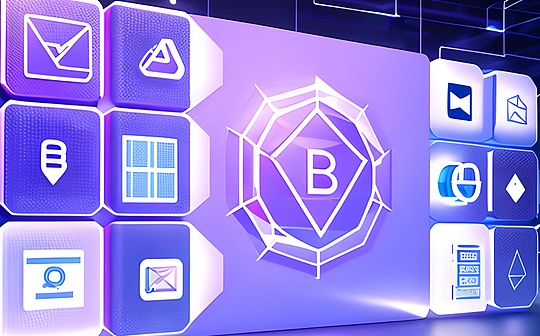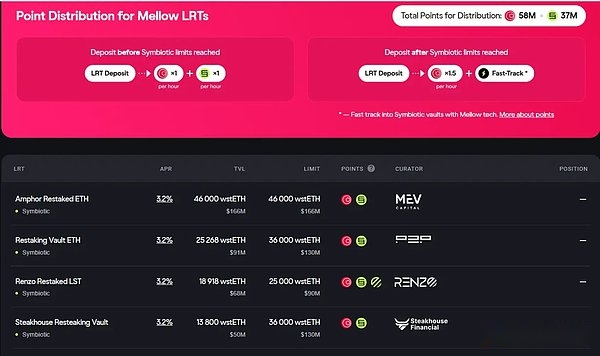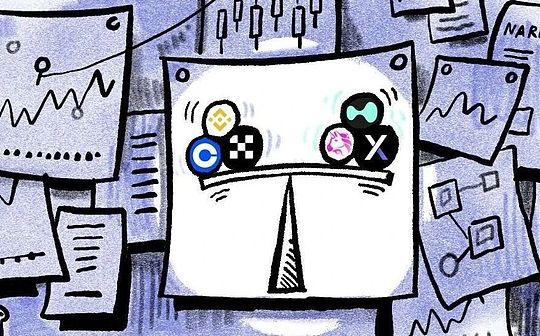
In April, ChainCatcher sorted out the re-staking agreement and LRT protocol of Ethereum, “Frequently supported capital, take turns to airdrop the projects, and re-staking the LRT track to become the “Nuggets New Holy Land””, which includes EigenLayer and its LRT protocol, such asRenzo, Ether.fi, Kelp DAO, EigenPie, YieldNest, Swell, Pendle Finance, etc.
Although Renzo’s token issuance and EigenLayer airdrops have been expected to be implemented, the market popularity of re-pled tracks in the past three months is still the same. “Points War + Eat More Fish” is still very popular in the crypto community, with tens of millions of dollarsLarge-scale financing at the level often occurs.
For example, on June 18, Renzo announced the completion of a $17 million financing led by Galaxy Ventures and others; on June 11, replenishment project Symbiotic announced the completion of a $5.8 million seed round of financing, led by Paradigm and Cyber Fund.
Data shows that 16.3% of all pledged ETHs participated in the re-staking of Eigenlayer, Karak_Network, etc.
Perhaps because of the opportunity to re-polize wealth, the narrative position of the re-polization track has been spilling out recently, from Ethereum in the main position to Bitcoin, Solana and other ecosystems.
It is reported that at least 6 teams in the Solana ecosystem are building Solana re-staking projects.
Recently, there have been two financings of more than ten million in the Bitcoin ecosystem. On May 30, Babylon completed a US$70 million financing led by Paradigm; on July 2, Lombard completed a US$16 million seed round of financing, which was led by Bitcoin re-staking agreement., Polychain Capital led the investment.
Three major re-staking agreements on Ethereum: EigenLayer, Symbiotic, and Karak Network
EigenLayer Airdrop Tokens are untransferable and controversial
As the pioneer of the Restaking concept, EigenLayer has always been the leading project in the re-staking track.However, since EigenLayer announced the EIGEN token economic model on April 30 and stated that the airdrop tokens are not transferable, it has caused a series of public opinion storms.
What is most criticized by users is that EigenLayer stated in the white paper that the initial stage of EIGEN tokens restricted the transfer rights and did not support user transfer or transactions.This means that users cannot buy, sell or trade EIGEN tokens in the secondary market.
The official explanation is that it is due to lack of liquidity, but in the eyes of users, this is undoubtedly the project party is playing a hooligan. The stablecoin Ethena project, which has just completed the airdrop release, posted a message on social media, “Tokens are transferable, we love you” and sarcastic..
In addition to the non-transferable tokens, EigenLayer also restricts the user’s IP when airdropping, which makes users even more dissatisfied, because EigenLayer does not use IP restrictions on the early pledge deposit page. It was not until the airdrop was released that it would restrict IP to allow participating users to haveThe feeling of killing a donkey is like a person who has been unloaded.
However, judging from the data changes, airdrop public opinion has not had an impact on TVL on EigenLayer, but has increased, from a maximum of $14 billion on May 9 to $19 billion on June 16, and has now beenRetraceed to $14.9 billion.
EigenLayer supports native restaking and liquid restaking: 68% of assets are native ETH and 32% are LST.Currently, EL has about 161,000 replenishers, but about 67.6% (about $10.3 billion) of assets are entrusted to just 1,500 operators.
On July 3, EigenLayer posted on social platform X that “major projects will be promoted in Q3.”Community users speculate that it is very likely that the EIGEN token will support transactions.
As of July 12, EIGEN tokens still do not support transfer or trading, and the price on the OTC secondary points trading market was $5.39.
Resolution new project backed by Lido and Paradigm Symbiotic
When EigenLayer was in a turmoil over airdrop rules, on May 15, Lido co-founder and Paradigm were revealed to be secretly funding a new project, Symbiotic, to compete in the re-staking track.In the community’s view, the time when re-polition Symbiotic appears is more like a counterattack against the dominant EigenLayer family.
On June 11, Symbiotic announced its official launch and completed a $5.8 million seed round, led by Paradigm and Cyber Fund.
Among them, Symbiotic’s second largest investor, Cyber Fund, was co-founded by Lido co-founders Konstantin Lomashuk and Vasiliy Shapovalov, and the Symbiotic platform publicly stated that it supports users to re-private assets such as Lido’s stETH and other assets that are natively incompatible with EigenLayer.
Therefore, Symbiotic is also considered to be the fill-up for Lido in the re-staking track vacancy and is a direct competitor to EigenLayer.
Unlike EigenLayer that only supports ETH and its (LSD-like ETH) derivatives, Symbiotic supports more diverse types of re-pending assets, which supports depositing any ERC-20 tokens as re-pending. For example, re-pending assets not only support Lido’s stETH,LSD pledged certificate assets such as cbETH also support the governance tokens ENA and stablecoin USDe of the stablecoin protocol Ethena.
This means that the encryption protocol can initiate native stakes for its own native tokens through the Symbiotic platform to improve network security.
In terms of product form, Symbiotic supports customized according to developers’ business needs. For example, using Symbiotic’s protocol or new network, you can choose its pledged asset type, node operator, rewards and reduction mechanisms, etc.Eigenlayer adopts a centralized management method, which is officially managed to pledge ETH, and node operators verify various AVS, etc.
With the support of Lido and Paradigm, Symbiotic has deposited crypto assets worth more than $1 billion in just one month after its launch.
As of July 12, Symbiotic platform TVL was $1.09 billion, of which the wstETH value of Lido deposited was $760 million, accounting for about 70% of TVL.
At present, LRT protocols such as Ether.fi, Renzo, YieldNest, Swell, Pendle Finance, etc. have been integrated with Symbiotic to support users to deposit assets on LRT to earn Symbiotic points.
Symbiotic-based LRT protocol Mellow
Mellow was originally a liquidity solution and was a partner of the Lido Alliance. It supports users to stake ETH on the platform and earn additional Mellow staking points.Additionally, Mellow has helped Lido operators launch their own LRTs to increase stETH availability and increase revenue for Lido DAO members.
On June 4, Mellow announced a partnership with Symbiotic as a modular LRT liquidity restaking project in its ecosystem.
Compared with the common LRT protocols, Mellow is more like a creation of modular LRT infrastructure that allows anyone to deploy or create LRTs with different risk or return ratios, such as traditional hedge funds, staking providers (such as Lido), etc.Support pledge users to choose different risk configurations according to their needs to achieve flexible risk management and profit optimization.
For users, they can directly save ETH to the Mellow platform, and the platform will automatically transfer ETH to Lido, and the user will receive stETH and save stETH to Symbiotic.Users can also obtain double points from the Symbiotic+Mellow platform when depositing ETH in Mellow.

On July 15, TVL on Mellow’s platform was $488 million and earned 37 million Symbiotic points.
Re-staking protocols that support multi-type asset and multi-chain deployment Karak Network
Karak Network works similarly to the Eigenlayer protocol, except that its AVS service is called the distributed security service DSS and has also launched its own Layer2 network K2.
Unlike Eigenlayer, Karak aims to support any asset to be replenished. The replenished assets currently supported on the platform include ETH, various LST and LRT assets, as well as USDT, USDC, DAI, USDe and other stablecoins.
In addition, Karak is also deployed in multiple chains, aiming to be deposited on any chain. It has been deployed on Ethereum, Arbitrum, BSC, Blast, Mantle, etc. Users can use multi-chain distribution based on their assets.Deposit assets.

However, the TVL on the Karak platform has now exceeded US$1 billion and does not support new fund deposits for the time being.
Bitcoin chain re-staking protocol: Babylon, Lombard, BounceBit
Bitcoin Re-staking Agreement Babylon
Babylon is a Bitcoin-based restaking protocol. It introduces staking (staking) functionality for Bitcoin, allowing BTC holders to pledge their assets to other protocols or services that require security and trust without trust, thereby obtaining PoSThe pledge income and governance rights are also passed on Bitcoin security to various middleware, data availability layer, side chain and other protocols, allowing them to enjoy Bitcoin-level security at a lower cost.
From the perspective of business scope, Babylon covers two aspects: First, BTC holders can pledge BTC, provide security and trustworthiness layers for other protocols, and earn profits from it; second, let PoS chains or other Bitcoin ecosystemsNew protocols in the system may be able to utilize BTC stakers as verification nodes to improve security and efficiency.
Babylon co-founder once said in an interview with ChainCatcher that in terms of working mechanism, Babylon is consistent with Ethereum’s re-staking protocol EigenLayer, but since Bitcoin does not support smart contracts, Babylon needs to do one more step than EigenLayer to allow unstaken Bitcoin to be first.It becomes pledged before it can be pledged again.
On May 30, Babylon once again announced the completion of a $70 million financing led by Paradigm.According to Rootdata data, as of July 12, Babylon’s public financing amount has reached US$96 million, and investment institutions include Paradigm, Polychain Capital, Framework Ventures, Polygon Ventures, Binance Labs and other well-known capitals.
Currently, users can experience the process of staking BTC through Babylon Testnet4 test.

Liquidity re-staking agreement based on Babylon
1. Seed round of $16 million Lombard
Lombard is a liquidity re-staking agreement built on Babylon. On July 2, it announced the completion of a US$16 million seed round led by Polychain Capital. Participants include BabylonChain, Foresight Ventures, Mirana Ventures, Nomad Capital, etc.
The relationship between Lombard and Babylon is similar to that between Renzo and EigenLayer. BTC pledged by users to Lombard will be automatically re-staked to the Babylon platform to earn income.
The Lombard platform releases the liquidity of the BTC pledged in Babylon through LBTC, that is, the user deposits BTC on the Lombard platform and receives equal proportion of re-pending certificate assets LBTC. The LBTC held can be used in the DeFi protocol, such as lending and transactions.and pledge, etc., to improve the efficiency of capital use.
Currently, users can use their email address to apply for a waitlist for the test list on the Lombard platform.
2. Lorenzo
Lorenzo is also a Bitcoin liquidity re-staking protocol based on Babylon. Users can deposit BTC directly into Babylon through Lorenzo. The platform has received support from Binance Labs.
On May 28, Lorenzo announced the launch of the pre-staked Babylon activity. Users can stake BTC on the pre-staked Babylon activity page to obtain stBTC. All BTCs received by Lorenzo will participate in the pledge as soon as Babylon is launched.
Currently, users can earn double points from Lorenzo and Babylon by staking BTC on Lorenzo.
Bitcoin re-staking chain BounceBit
BounceBit is a BTC re-staking chain designed specifically for Bitcoin. Its main products include three major sectors: BounceBit Portal, BounceBit Chain, and BounceClub.Among them, BounceBit Portal is the user interaction portal, BounceClub aims to become the combination ecosystem of CeFi and DeFi, and BounceBit Chain is the main module of the re-stake function.
BounceBit Chain is designed as a carrier for implementing re-staking functions in the BounceBit ecosystem. It is protected by the verifier’s staked Bitcoin and BounceBit native token BB. Middleware such as cross-chain bridges, oracles, etc. can be obtained by introducing BounceBit’s liquidity.Security.
Specifically, after the user transfers the native assets to BounceBit, a new B-Token asset will be minted.Taking BTC as an example, after a user deposits BTC, he will obtain BBTC assets operating on the BounceBit main network.
Currently, BBTC assets can be used for two main on-chain activities: one is to use BBTC+BB to participate in node staking in BounceBit’s hybrid staking mode, and the LST tokens generated at the same time can be used for further restaking activities to amplifyStaking returns; secondly, BBTC can be used to interact with various DeFi applications on the chain to obtain profits.
In April, BounceBit announced the completion of a strategic round of financing invested by Binance Labs.As early as February, it announced that it had completed a $6 million seed round, with investors including Blockchain Capital, Bankless Ventures, NGC Ventures, DeFiance Capital, OKX Ventures, etc.
On July 12, BB quoted $0.40 and FDV of $800 million.
Solana Ecological Re-Pledge Agreement: Solayer, Cambrian, Picasso
Liquidity Re-staking Agreement Solayer
Solayer is the re-staking agreement of the Solana ecosystem, which supports SOL holders to pledge their assets to other Solana in-eco-protocols or DApp services that require security and trust, thereby obtaining more PoS staking income. Its function is similar to EigenLayer.
On July 2, the builder round of financing was announced, and the specific investment amount was not disclosed. Investors include Solana Labs Anatoly Yakovenko, Solend founder Rooter, Tensor Richard Wu, Polygon Sandeep Nailwal, etc.It was previously revealed that three VCs familiar with the situation said Solayer hopes to complete a $8 million seed round at a $80 million valuation.Rachel Chu of Solayer Labs said it was close to raising $10 million, with Solana founder Anatoly Yakovenko participating.
Currently, Solayer supports users to deposit native SOL, mSOL, JitoSOL and other assets. On July 15, TVL on the Solayer platform exceeded US$105 million, of which SOL accounts for about 60%.

Replenishment Agreement in Financing Negotiation Cambrian
Cambrian is also a re-staking agreement of the Solana ecosystem, supporting SOL and LST assets to middleware or Dapp applications to earn more profits.
It is reported that Cambrian founder Gennady Evstratov said that the team is finalizing a $2.5 million financing, and three investors said they are valued at about $25 million. Cambrian plans to launch a re-pled network at the end of the second quarter or early in the third quarter to earn points onlinePlan to send coins.
As of July 15, Cambrian has not launched any pledged products.
Re-staking Agreement Picasso
Picasso was originally a cross-chain protocol of Polkadot ecosystem. On January 28, it announced the launch of SOL’s re-staking service to support SOL and LST liquid pledged assets to protect middleware, dApps and L2 Rollups and other AVS (active verification services).

Currently, the re-pled products on Picasso support re-private SOL and LST assets such as JitoSOL, mSOL, and bSOL.However, the current replenished assets on the platform that participate in locking positions are only US$3.75 million.







